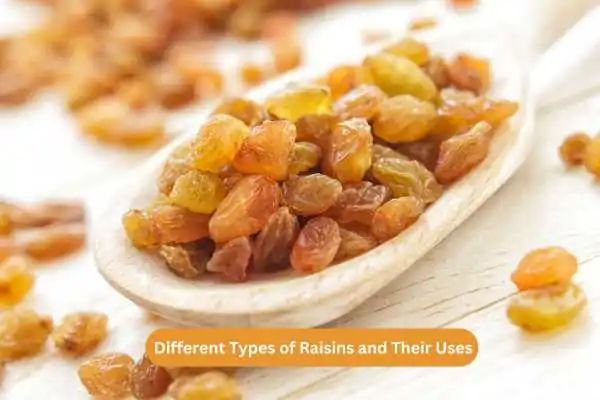Raisins are a staple in many UK households, loved for their natural sweetness, chewy texture, and versatility. These dried fruits are more than just a snack—they’re essential ingredients in both traditional and modern recipes, from comforting baked goods to savoury mains. But not all raisins are the same. Different types of raisins offer unique flavours, colours, and culinary uses.

In this guide, we’ll explore the most common types of raisins, what makes each variety special, and how best to use them in everyday cooking and baking.
1. Thompson Seedless Raisins
Overview
Thompson seedless raisins are the most widely recognised type in the UK. Made from green seedless grapes, they turn a deep brown colour during the drying process. They’re sun-dried naturally, resulting in a chewy texture and mildly sweet flavour.
Best Uses
-
Baking: Ideal for cakes, scones, and fruit loaves.
-
Snacking: Perfect for lunchboxes or a quick energy boost.
-
Cooking: Common in traditional dishes like spotted dick and bread pudding.
Their balanced sweetness makes them a go-to option for both sweet and savoury applications.
2. Golden Raisins (Sultanas)
Overview
Golden raisins, commonly known in the UK as sultanas, are dried using a controlled dehydration method with sulphur dioxide to retain their light colour. They are slightly plumper and more moist than Thompson raisins, with a tangier, lighter taste.
Best Uses
-
Baking: Excellent in hot cross buns and sultana scones.
-
Salads: Add a sweet contrast to couscous or grain salads.
-
Breakfast: A great mix-in for porridge, granola, or overnight oats.
Their light colour and mild flavour pair well with a wide range of dishes, especially those needing subtle sweetness.
3. Currants (Zante Currants)
Overview
Despite the name, Zante currants are actually dried Black Corinth grapes. They are much smaller than traditional raisins and have a dark colour with a bold, tangy flavour. Popular in British cuisine, currants are a key ingredient in classic recipes.
Best Uses
-
Traditional Baking: Essential in Eccles cakes, mince pies, and Welsh cakes.
-
Stuffings: Great in savoury stuffing mixes for poultry or pork.
-
Muffins and Bars: Provide bursts of intense flavour in every bite.
Their size and robust taste make currants perfect for recipes where a strong fruity presence is needed without overpowering the dish.
4. Black Raisins
Overview
Black raisins are sun-dried from black Corinth or other dark grape varieties. They are darker, sweeter, and softer than Thompson raisins, offering a deeper flavour profile.
Best Uses
-
Trail Mixes: Their bold flavour pairs well with nuts and seeds.
-
Desserts: Use in rice pudding or fruit compotes for a rich taste.
-
Smoothies: A natural sweetener in shakes or smoothie bowls.
These raisins are particularly popular in Eastern European and Middle Eastern cooking and are becoming more common in UK recipes.
5. Green Raisins
Overview
Less common in the UK but available in specialist or health food shops, green raisins are made from seedless green grapes dried in a shaded environment to preserve their colour and natural sweetness. They are long and slightly chewy with a sweet, tart flavour.
Best Uses
-
Gourmet Dishes: Add to pilafs, Persian rice, or tagines.
-
Cheese Boards: Pair beautifully with aged cheeses and nuts.
-
Health Snacks: Excellent in energy bars or eaten on their own.
Green raisins are valued for their distinct appearance and are ideal when you want something a bit different from the usual varieties.
6. Red Raisins
Overview
Made from red seedless grapes, red raisins are dried similarly to black raisins but retain a more vibrant red-brown hue. They are sweet, plump, and slightly tangy.
Best Uses
-
Fruit Salads: Their colour and flavour stand out in mixed fruit dishes.
-
Baking: Use in muffins, bread, or oat bars.
-
Sauces: Great for chutneys or compotes with meat dishes.
Red raisins are gaining popularity for their aesthetic appeal and are often used in festive cooking.
How to Store Raisins Properly
To maintain freshness, keep raisins in an airtight container in a cool, dry place. For longer storage, refrigeration is recommended—especially during warmer months. Always check the packaging for best-before dates and store away from strong-smelling foods, as raisins can absorb odours.
Nutritional Note
Raisins are naturally high in fibre, iron, and antioxidants. They’re a great source of quick energy, especially for active lifestyles. However, they are calorie-dense, so moderation is key. Choosing unsweetened, preservative-free options ensures you’re getting the healthiest version.
Final Thoughts
Whether you’re baking a classic fruitcake, preparing a Moroccan couscous, or just looking for a wholesome snack, there’s a raisin to suit your needs. Understanding the different types of raisins and their uses allows you to get creative in the kitchen and make more informed choices when shopping.
From golden sultanas to bold black raisins, each variety offers its own unique flavour, texture, and culinary potential. Embrace the diversity of this humble dried fruit and enjoy all it has to offer in your everyday meals

